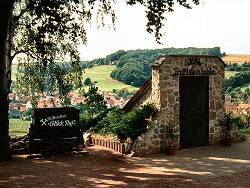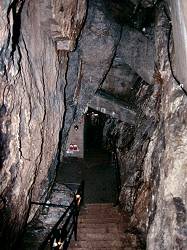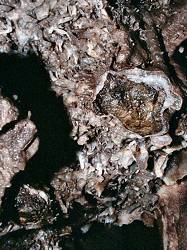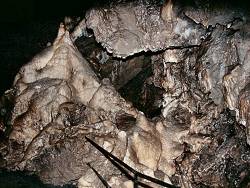Kittelsthaler Tropfsteinhöhle
Dripstonecave of Kittelsthal
Useful Information


| Location: |
Bergstraße, 99842 Ruhla OT Kittelsthal.
A4 exit 39 Eisenach-West, B19/B88 to Thal. A4 exit 40b Sattelstadt, via Sattelstadt to Wutha, turn left B88 to Thal. Turn right towards Kittelsthal, right into Am Acker, signposted. (50.923758088544110, 10.39229532939734) |
| Open: |
APR to OCT Thu, Fri 10-18, Sat, Sun, Hol 13-18. NOV to MAR Thu-Sat 10-18. [2022] |
| Fee: |
Adults EUR 5, Children EUR 3. Groups (20+): Adults EUR 3, Children EUR 2. [2022] |
| Classification: |
 Karst Cave Karst Cave
 Copper Mine Copper Mine
|
| Light: |
 Electric Light Electric Light
|
| Dimension: | L=726 m, VR=48 m, T=8 °C, A=348 m asl. |
| Guided tours: |
L=158 m, VR=48 m, D=45 min, St=228, MinAge=3. V=10.000/a [1993], V=6,000/a [2005]. |
| Photography: | allowed |
| Accessibility: | no |
| Bibliography: |
Klaus Schöllhorn, Anita Schöllhorn, G. Malcher (2006):
Die Kittelsthaler Tropfsteinhöhle
Hrsg.: Stadtverwaltung Ruhla. 4. überarbeitete Auflage. Verlag + Druckerei Löhr, Ruhla 2006.

|
| Address: |
Tropfsteinhöhle, Bergstraße, 99842 Ruhla OT Kittelsthal, Cell: +49-160-94450973.
E-mail: Naturpark-, Geopark- und Tourist Information Ruhla, Neuer Markt 1, 99842 Ruhla, Tel: +49-36929-89013. E-mail: |
| As far as we know this information was accurate when it was published (see years in brackets), but may have changed since then. Please check rates and details directly with the companies in question if you need more recent info. |
|
History
| 1888 | first natural caverns mentioned. |
| 1894 | discovery of more caverns. |
| 1894-1896 | development as a show cave. |
| 1918 | first electric light. |
| 1924 | Mining in Wolfsberg hill ends for economic reasons. |
| 1945-1954 | closed to the public because of safety reasons. |
| 1954 | restoration of the entrance tunnel and reopening of the show cave. |
| 1966 | The Raimund family sells the cave to the community of Kittelsthal. |
| 1968 | collapse of the ceiling in the area called the Drei Gleichen. Cave closed because of security reasons. |
| 1980 | after another collapse in the mining part, the Bergsicherung (mining security) started stabilizing the mine. |
| 1991 | restoration of the show cave. |
| 11-SEP-1992 | reopening of the show cave. |
Description


The Kittelsthaler Tropfsteinhöhle (Kittelsthal Dripstone Cave) is quite an unusual combination of cave and mine. It is indeed a karst cave, and that is why we have listed it as a show cave, but it was discovered by mining in 1888. After more rooms were discovered in 1894, apparently it is a group of small caves, the caves were developed and opened to the public in 1896. It was still in operation as a show cave during the Second World War, but it was closed in 1945. In 1954, it was reopened after renovations. In 1966, the Raimund family sold the cave to the municipality of Kittelsthal. In 1968, a collapse occurred and mountain safety measures became necessary. Because of the rather low number of visitors and the unpredictable risks, it was closed. Nevertheless, it was further explored by the Kittelsthaler Höhlenforschungsgruppe (Kittelsthal cave research group) and various new discoveries were made.
Eventually, a tunnel collapsed right next to the Gasthaus Zur Tropfsteinhöhle, a restaurant named after the adjacent cave. Therefore, from 1980 onwards, Bergsicherung Ilfeld carried out safety measures in the cave and the mining parts above it. These safety measures for the old mine lasted a decade and were not completed until after the fall of the Wall. Adits were backfilled, concrete seals were installed, and sections were secured with anchors. Now that safety was guaranteed, the municipality planned to reopen the show cave as its biggest attraction. With little financial means, the cave was renovated with ABM workers (unemployed people working for wages paid by the unemployment insurance) and reopened after only one and a half years in 1992. Then it was closed for two years because of the Corona pandemic, but is now open again, and quite exceptional its open all year round. We are not sure if this will stay so, because there is bat protection law and there are probably not enough visitors during winter.
Mining followed an ore-bearing fissure and so today you climb down a long staircase of 228 steps in this fissure. During the descent the visitor reaches several times natural cavities, which are decorated with rather unspectacular but sometimes quite interesting cave minerals. Worth mentioning from a touristic point of view is the 3.5 m high stalagmite called Pyramide (pyramid) in the Große Grotte (Big Grotto). Much more interesting, however, are the helictites, the calcite crystals, hidden in small niches, and the baryte gangue.
The area around Thal is a karst region and has many caves, most of which are small. In addition, they are often filled in with sediments. Caves such as the Ritterhöhle, the Hohle Stein, or the Backofenloch have been known and accessible for a long time. And cavities were also frequently discovered during mining and often used as a practical opportunity to store overburden. Mining for copper-bearing ore veins was carried out underground and also in open casts, with varying success. Later, gypsum was also mined. In the 19th century, baryte (barite) and fluorite (fluorspar) became economically interesting.
The mine was operated by Steiger Hess, and the preservation of the cavities is thanks to him, as he recognised their touristic value and stopped filling them in. He was responsible for the development and became the first cave guide, he even installed gas lighting. It was used for more than 20 years, when finally the lighting was converted to electricity. In true style, the lamps were fitted with green plants and garden gnomes. During this time, the cave was called the Thaler Tropfsteinhöhle or Tropfsteinhöhle bei Thal (Stalactite Cave near Thal).
 Search DuckDuckGo for "Kittelsthaler Tropfsteinhöhle"
Search DuckDuckGo for "Kittelsthaler Tropfsteinhöhle" Google Earth Placemark
Google Earth Placemark Kittelsthaler Tropfsteinhöhle
Kittelsthaler Tropfsteinhöhle  SIGHTS IN RUHLA, THAL, KITTELSTHAL & SEEBACH (visited: 17-NOV-2022)
SIGHTS IN RUHLA, THAL, KITTELSTHAL & SEEBACH (visited: 17-NOV-2022) Index
Index Topics
Topics Hierarchical
Hierarchical Countries
Countries Maps
Maps